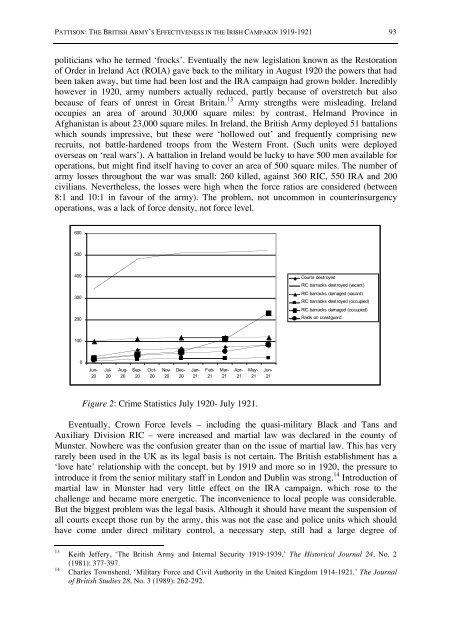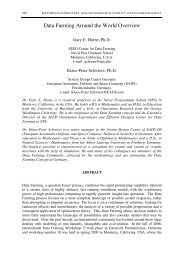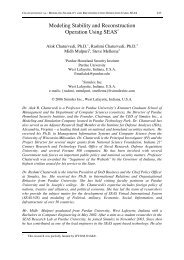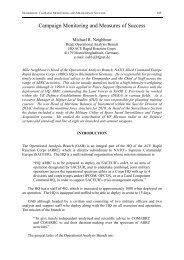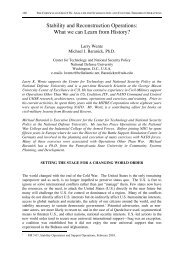The British Army's Effectiveness in the Irish ... - Cornwallis Group
The British Army's Effectiveness in the Irish ... - Cornwallis Group
The British Army's Effectiveness in the Irish ... - Cornwallis Group
Create successful ePaper yourself
Turn your PDF publications into a flip-book with our unique Google optimized e-Paper software.
PATTISON: THE BRITISH ARMY’S EFFECTIVENESS IN THE IRISH CAMPAIGN 1919-1921 93<br />
politicians who he termed ‘frocks’. Eventually <strong>the</strong> new legislation known as <strong>the</strong> Restoration<br />
of Order <strong>in</strong> Ireland Act (ROIA) gave back to <strong>the</strong> military <strong>in</strong> August 1920 <strong>the</strong> powers that had<br />
been taken away, but time had been lost and <strong>the</strong> IRA campaign had grown bolder. Incredibly<br />
however <strong>in</strong> 1920, army numbers actually reduced, partly because of overstretch but also<br />
because of fears of unrest <strong>in</strong> Great Brita<strong>in</strong>. 13 Army strengths were mislead<strong>in</strong>g. Ireland<br />
occupies an area of around 30,000 square miles: by contrast, Helmand Prov<strong>in</strong>ce <strong>in</strong><br />
Afghanistan is about 23,000 square miles. In Ireland, <strong>the</strong> <strong>British</strong> Army deployed 51 battalions<br />
which sounds impressive, but <strong>the</strong>se were ‘hollowed out’ and frequently compris<strong>in</strong>g new<br />
recruits, not battle-hardened troops from <strong>the</strong> Western Front. (Such units were deployed<br />
overseas on ‘real wars’). A battalion <strong>in</strong> Ireland would be lucky to have 500 men available for<br />
operations, but might f<strong>in</strong>d itself hav<strong>in</strong>g to cover an area of 500 square miles. <strong>The</strong> number of<br />
army losses throughout <strong>the</strong> war was small: 260 killed, aga<strong>in</strong>st 360 RIC, 550 IRA and 200<br />
civilians. Never<strong>the</strong>less, <strong>the</strong> losses were high when <strong>the</strong> force ratios are considered (between<br />
8:1 and 10:1 <strong>in</strong> favour of <strong>the</strong> army). <strong>The</strong> problem, not uncommon <strong>in</strong> counter<strong>in</strong>surgency<br />
operations, was a lack of force density, not force level.<br />
600<br />
500<br />
400<br />
300<br />
200<br />
100<br />
0<br />
Jun-<br />
20<br />
Jul-<br />
20<br />
Aug-<br />
20<br />
Sep-<br />
20<br />
Oct-<br />
20<br />
Nov-<br />
20<br />
Dec-<br />
20<br />
Jan-<br />
21<br />
Feb-<br />
21<br />
Mar-<br />
21<br />
Apr-<br />
21<br />
May-<br />
21<br />
Figure 2: Crime Statistics July 1920- July 1921.<br />
Jun-<br />
21<br />
Courts destroyed<br />
RIC barracks destroyed (vacant)<br />
RIC barracks damaged (vacant)<br />
RIC barracks destroyed (occupied)<br />
RIC barracks damaged (occupied)<br />
Raids on coastguard<br />
Eventually, Crown Force levels – <strong>in</strong>clud<strong>in</strong>g <strong>the</strong> quasi-military Black and Tans and<br />
Auxiliary Division RIC – were <strong>in</strong>creased and martial law was declared <strong>in</strong> <strong>the</strong> county of<br />
Munster. Nowhere was <strong>the</strong> confusion greater than on <strong>the</strong> issue of martial law. This has very<br />
rarely been used <strong>in</strong> <strong>the</strong> UK as its legal basis is not certa<strong>in</strong>. <strong>The</strong> <strong>British</strong> establishment has a<br />
‘love hate’ relationship with <strong>the</strong> concept, but by 1919 and more so <strong>in</strong> 1920, <strong>the</strong> pressure to<br />
<strong>in</strong>troduce it from <strong>the</strong> senior military staff <strong>in</strong> London and Dubl<strong>in</strong> was strong. 14 Introduction of<br />
martial law <strong>in</strong> Munster had very little effect on <strong>the</strong> IRA campaign, which rose to <strong>the</strong><br />
challenge and became more energetic. <strong>The</strong> <strong>in</strong>convenience to local people was considerable.<br />
But <strong>the</strong> biggest problem was <strong>the</strong> legal basis. Although it should have meant <strong>the</strong> suspension of<br />
all courts except those run by <strong>the</strong> army, this was not <strong>the</strong> case and police units which should<br />
have come under direct military control, a necessary step, still had a large degree of<br />
13<br />
Keith Jeffery, ‘<strong>The</strong> <strong>British</strong> Army and Internal Security 1919-1939,’ <strong>The</strong> Historical Journal 24, No. 2<br />
(1981): 377-397.<br />
14<br />
Charles Townshend, ‘Military Force and Civil Authority <strong>in</strong> <strong>the</strong> United K<strong>in</strong>gdom 1914-1921.’ <strong>The</strong> Journal<br />
of <strong>British</strong> Studies 28, No. 3 (1989): 262-292.


